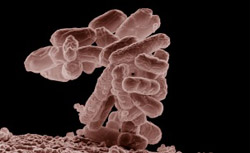Computer models figure out sickle cell crisis
A sickle cell crisis isn’t just about sickle-shaped red blood cells that block capillaries. A second, stickier kind of red blood cell starts the obstruction, making it difficult for sickle cells to flow past.
PROVIDENCE, R.I. [Brown University] — Using powerful computer models, researchers from Brown University have shown for the first time how different types of red blood cells interact to cause sickle cell crisis, a dangerous blockage of blood flow in capillaries that causes searing pain and tissue damage in people with sickle cell disease.
The models showed that the rigid, crescent-shaped red blood cells that are the hallmark of sickle cell disease don’t cause these blockages on their own. Instead, softer, deformable red blood cells known as SS2 cells start the process by sticking to capillary walls. The rigid sickle-shaped cells then stack up behind the SS2s, like traffic behind a car wreck. (more…)


